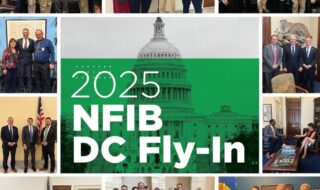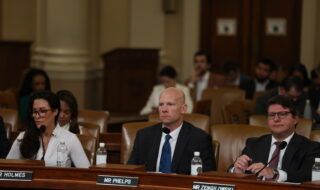Topics:
New NFIB COVID Survey: Small Business Owners Impacted by Surge in COVID Cases, Supply Chains, and Staffing Shortage to Start New Year
New NFIB COVID Survey: Small Business Owners Impacted by Surge in COVID Cases, Supply Chains, and Staffing Shortage to Start New Year
January 13, 2022 Last Edit: June 5, 2025
New NFIB COVID Survey: Small Business Owners Impacted by Surge in COVID Cases, Supply Chains, and Staffing Shortage to Start New Year
- The recent increase in COVID-19 cases has negatively impacted about two-thirds of small business owners to varying degrees.
- Eleven percent of owners reported the surge in COVID-19 cases has a significant impact on their business, 23% reported a moderate negative impact, and 34% a mild negative impact.
- Of those negatively impacted, 19% reported that the rise in cases is significantly impacting employee work attendance. Twenty-three percent say that it’s moderately impacting work attendance, and 34% report a mild impact.
- Related to sales, 10% of owners negatively impacted reported that the recent surge is significantly impacting sales, 26% report it is moderately impacting sales, and 34% report the increase is mildly impacting sales.
- Nearly half (47%) of small business owners reported supply chains had a significant impact on their business, 27% reported it having a moderate impact, and 18% said it had a mild impact. Eight percent reported supply chain disruptions not an issue.
- Forty-four percent of small business owners who are experiencing disruptions say that the disruption is worse not than it was three months ago, a decline from 62% in October.
- The vast majority (87%) of small business owners anticipate the supply chain disruption that is impacting their business to continue for five months or more.
- Twenty-three percent of small employers are currently experiencing a significant staffing shortage and 20% are experiencing a moderate staffing shortage.
- Of those employers currently experiencing a staffing shortage, 14% are experiencing significant loss of sales opportunities and 23% report moderate loss of sales opportunities.
- The severity of lost sales opportunities has lessened since late October likely due to more owners successfully adjusting operations to accommodate demand.
- The staffing shortage is not easing for most small employers as 45% reported that their current staffing shortage is about the same as it was three months ago. One-quarter of small employers reported it being worse and 5% reported their current staffing shortage is better than it was three months ago.
- Small employers facing staffing shortages are making adjustments to attract applicants for open positions: 83% increased wages, 24% increased paid time off, 20% offered or enhanced hiring bonuses, 24% offered or enhanced referral bonuses, and 29% offered or enhanced health insurance benefits.
- Small employers are also making business operations adjustments to compensate the staffing shortage: 43% are offering more hours to part-time employees, 61% are offering overtime to full-time employees, 88% reported that the owner(s) are working more hours, 38% have resorted to more drastic measures with adjusting business operation hours, 33% introduced new technology to enhance productivity, and 29% reduced the variety of goods and services sold.
- Sixty-four percent of small business owners have increased their average selling prices due to supply chain disruptions and/or increased compensation due to staffing shortages.
- Of those owners who raised prices, 41% have raised prices by 10% or more and 29% have raised prices 5% – 9.9%.
- Just over one-third (36%) of small businesses are at or exceeding pre-crisis sales levels, a 10-percentage point increase from early September when 26% of owners reported the same.
- Thirty-two percent of owners are nearly back to where they were with sales 75% – 99% of pre-crisis levels.
- Most small business owners reported that their local economy remains below pre-crisis levels of economic activity.
- Only 21% of owners reported that economic conditions are back to normal now in their area.
- Thirteen percent of owners anticipate an economic recovery in their first half of 2022 and another 27% report the second half of 2022 before economic conditions return to pre-crisis levels. Thirty-nine percent of small business owners expect conditions not to fully improve until 2023 or later.
- About one-third of small business owners reported that they received a second-draw Paycheck Protection Program (PPP) loan in 2021.
- The vast majority of owners (84%) have applied for PPP loan forgiveness applications for their second PPP loan.
- Only 14% of small employers reported they are very familiar with the Employee Retention Tax Credit (ERTC) and another 34% are somewhat familiar.
- Thirteen percent of small employers claimed the ERTC for wages in 2020 and another 12% claimed the ERTC for wages in 2021.
Get to know NFIB
NFIB is a member-driven organization advocating on behalf of small and independent businesses nationwide.
Related Articles

July 2, 2025
NFIB Key Votes One Big Beautiful Bill Act in U.S. Senate and Ho…
NFIB key votes the One Big Beautiful Bill Act in the 119th Congress and urg…
Read More


July 2, 2025
Small Business Owners Push Priorities in Capitol Hill Meetings
Over 80 small business owners attended NFIB’s annual Fly-In. They attende…
Read More



July 2, 2025
Small Business Owner Testifies Before U.S. House Committee on W…
Virginia NFIB member and small business owner Joshua Phelps spoke to the U….
Read More







